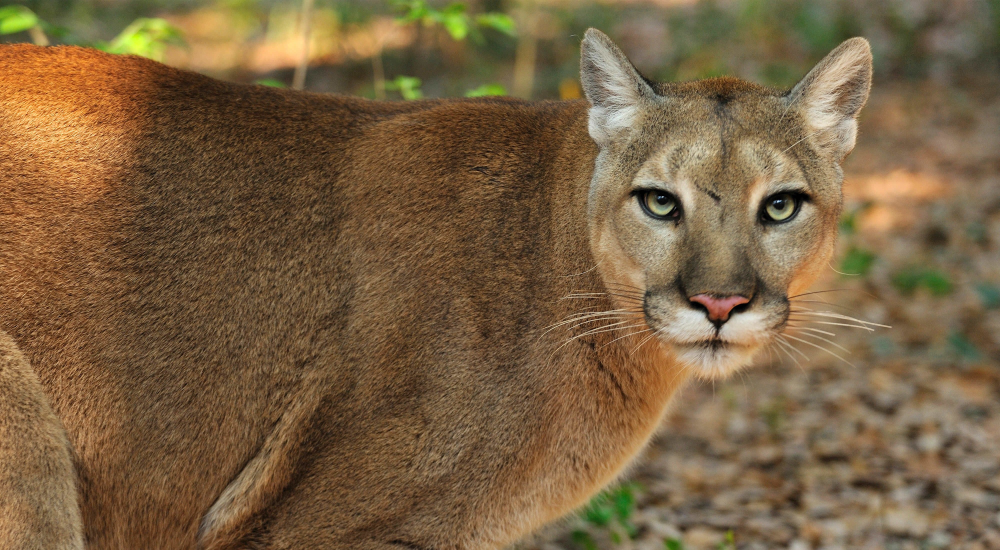In the wilds of the Sunshine State, where the dense, subtropical forests meet the sprawling wetlands, there roams a creature both elusive and iconic—the Florida Panther (*Puma concolor coryi*). With its sleek, tawny coat and piercing amber eyes, the Florida Panther cuts a figure of beauty and power in its native habitat. But behind its majestic facade lies a story of struggle and resilience, as this magnificent feline fights against the odds to survive in an ever-changing landscape.
A Symbol of Florida’s Wilderness
The Florida Panther holds a special place in the hearts of Floridians and wildlife enthusiasts alike. As the official state animal of Florida, it symbolizes the untamed wilderness that once dominated the region. Historically, these big cats roamed throughout the southeastern United States, from Arkansas to Louisiana and beyond. However, due to habitat loss, hunting, and other human activities, their range has been drastically reduced, confining them to a small pocket of land in southern Florida.
Habitat and Behavior of Florida Panther
Florida Panthers are solitary and territorial creatures, preferring to roam and hunt alone within their home ranges, which can span hundreds of square miles. They are primarily nocturnal, using their keen senses of sight and hearing to stalk and ambush their prey under the cover of darkness. Despite their large size and powerful build, these cats are remarkably elusive, often going unseen by humans for weeks or even months at a time.
The dense forests and swamps of the Florida Everglades provide the perfect habitat for these elusive predators, offering ample cover for stalking prey and raising their young. However, rapid urbanization and agricultural development have encroached upon their once vast territory, fragmenting their habitat and forcing them into closer proximity to human activity.
Threats to Survival
The Florida Panther faces numerous threats to its survival, chief among them being habitat loss and fragmentation. As the human population of Florida continues to grow, wild lands are converted into residential and commercial developments, leaving less room for wildlife to thrive. Roads and highways slice through the panther’s territory, increasing the risk of collisions with vehicles—a leading cause of mortality among these big cats.
Inbreeding depression is another significant concern for the Florida Panther population. With such a small and isolated gene pool, inbreeding occurs frequently, leading to genetic abnormalities and reduced reproductive fitness. Conservation efforts aimed at bolstering genetic diversity through the introduction of Texas cougars have helped mitigate this problem to some extent, but the long-term viability of the population remains uncertain.
Conservation Efforts for Florida Panther
Despite the challenges facing the Florida Panther, conservationists and wildlife agencies are working tirelessly to ensure its survival. The Florida Fish and Wildlife Conservation Commission (FWC) spearheads efforts to monitor and protect panther populations, conducting research, habitat restoration, and public outreach initiatives aimed at raising awareness about the plight of these endangered cats.
The establishment of protected areas such as the Florida Panther National Wildlife Refuge and the Big Cypress National Preserve has provided critical habitat for the panther to thrive. Conservation easements and land acquisitions have expanded these protected areas, creating wildlife corridors to connect isolated populations and allow for the natural movement of animals between different habitats.
 Looking to the Future
Looking to the Future
As Florida continues to undergo rapid development and urbanization, the future of the Florida Panther hangs in the balance. Conservationists stress the importance of preserving and restoring habitat corridors to ensure the long-term viability of the species. Efforts to reduce human-wildlife conflicts, such as the installation of wildlife crossings and the implementation of speed limits in panther habitat areas, are also crucial for preventing further population declines.
Education and outreach programs play a vital role in fostering coexistence between humans and panthers, encouraging responsible land use practices and promoting a greater appreciation for Florida’s natural heritage. By working together to protect this iconic species, we can ensure that future generations will have the opportunity to marvel at the beauty and grace of the Florida Panther in the wild.
In the heart of the Everglades, amidst the sawgrass and cypress trees, the Florida Panther continues to roam, a symbol of resilience in the face of adversity. It serves as a reminder of the importance of preserving our natural world and safeguarding the rich biodiversity that makes Florida truly unique. As stewards of the land, it is our duty to protect and cherish these magnificent creatures, ensuring that they remain a part of Florida’s landscape for generations to come.









